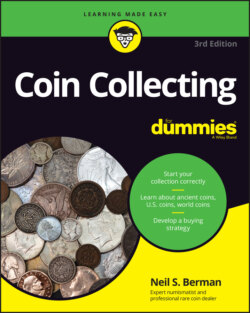Читать книгу Coin Collecting For Dummies - Neil S. Berman - Страница 36
Understanding the parts and purpose of a coin
ОглавлениеBefore you start collecting coins, it helps to know what a coin is.
Coins have three sides. The front of the coin is called the obverse; the back, the reverse; and the edge is … well, the edge. Modern coins are usually struck (stamped) from dies, which are pieces of metal (usually steel) with designs on them. There are three dies: the obverse die, the reverse die, and the collar die (which strikes the edge). Engravers (artists with engraving tools) create the designs on the dies. In the past, this work was done entirely by hand, but now much of this process is automated. Legends and mottoes are the words that you see on both sides of a coin. Many of the designs and wording are required by law; others are included at the discretion of the designer and the minting authority.
Coins are struck at a mint, which usually is a government-run operation. The number of coins struck is called the mintage. Coins are struck for the following uses:
General circulation: These coins are called business strikes, and they’re intended for use in commerce. The coins you have in your pocket or coin purse and spend throughout your day fall into this category.
Proofs: These coins are made especially for collectors. Today, the quality of proof coins is substantially higher than that of coins struck for circulation.
Believe it or not, now you know as much about coins as most beginning collectors do.
